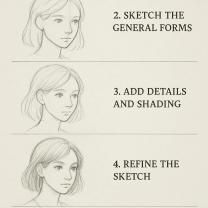How to draw a quadrilateral?
Sketching quadrilaterals can be a fascinating and creative endeavor. Here's a step-by-step guide to help you draw different types of quadrilaterals:
Materials Needed:
- Blank paper
- Pencil
- Ruler (optional)
- Protractor (optional)
Step 1: Understand Quadrilaterals:Before you start sketching, familiarize yourself with the characteristics of different types of quadrilaterals, such as squares, rectangles, parallelograms, and trapezoids.
Step 2: Choose a Quadrilateral to Draw:Decide which type of quadrilateral you want to draw. Let's start with a simple parallelogram.
Step 3: Draw the Base:Draw a horizontal line segment to serve as the base of your parallelogram. This will determine the length of one pair of opposite sides.
Step 4: Draw the Opposite Side:From the endpoints of the base, draw two slanting lines that are parallel to each other. These lines will represent the opposite side of the parallelogram.
Step 5: Connect the Endpoints:Connect the endpoints of the slanting lines to complete the parallelogram. Make sure the lines are straight and parallel.
Step 6: Add Details:You can label the vertices of the parallelogram as A, B, C, and D. You can also measure the angles using a protractor to make sure they are congruent (equal) opposite angles.
Step 7: Experiment with Other Quadrilaterals:Once you feel comfortable drawing parallelograms, you can explore other types of quadrilaterals. For example, to draw a rectangle, start with a square by drawing four equal sides and then adjust the lengths of opposite sides.
Step 8: Drawing a Square:To draw a square, start with a small horizontal line segment. At each endpoint, draw a vertical line segment perpendicular to the base. Connect the endpoints of the vertical lines to complete the square.
Step 9: Drawing a Trapezoid:To draw a trapezoid, start with a horizontal line segment as the longer base. From the endpoints of the longer base, draw two slanting lines that converge towards each other. Connect the endpoints of the slanting lines to complete the trapezoid.
Step 10: Practice and Experiment:Practice drawing different types of quadrilaterals using the steps outlined above. Experiment with varying the lengths of sides, angles, and orientations to create a variety of geometric wonders.
Remember that practice makes perfect. As you continue sketching quadrilaterals, you'll develop a better understanding of their properties and be able to draw them with more precision and creativity. Happy sketching!












